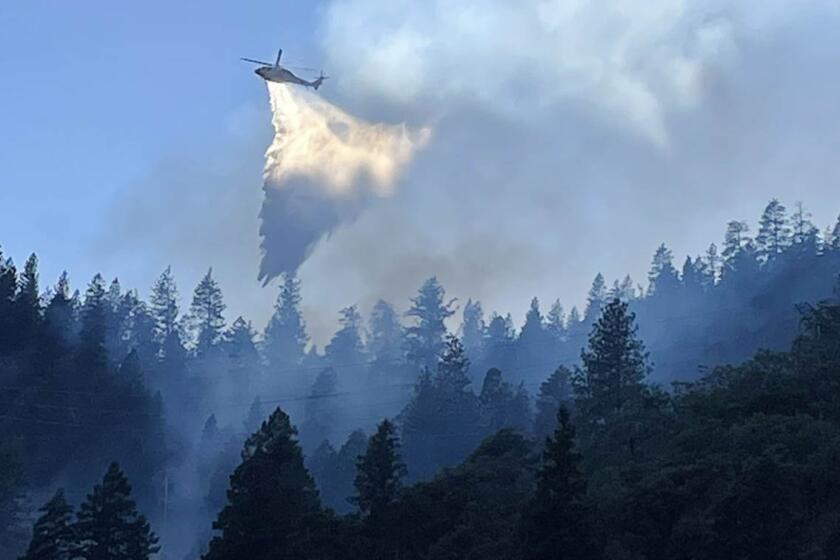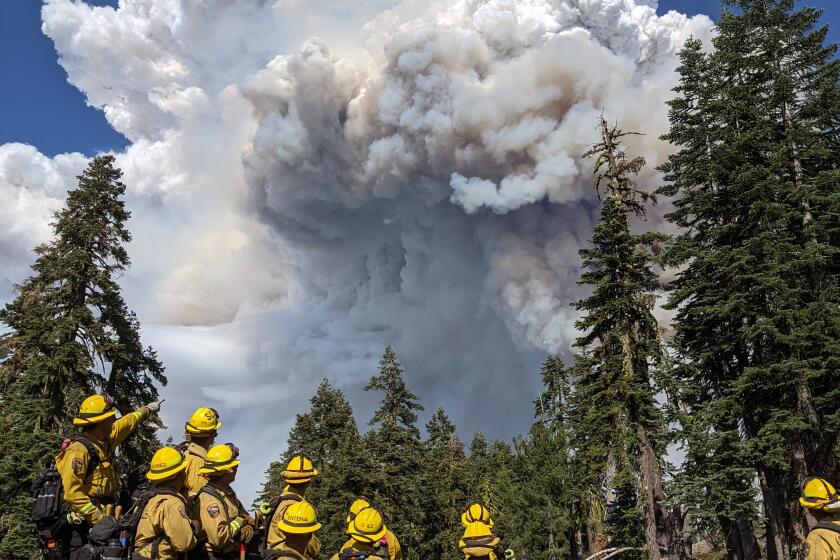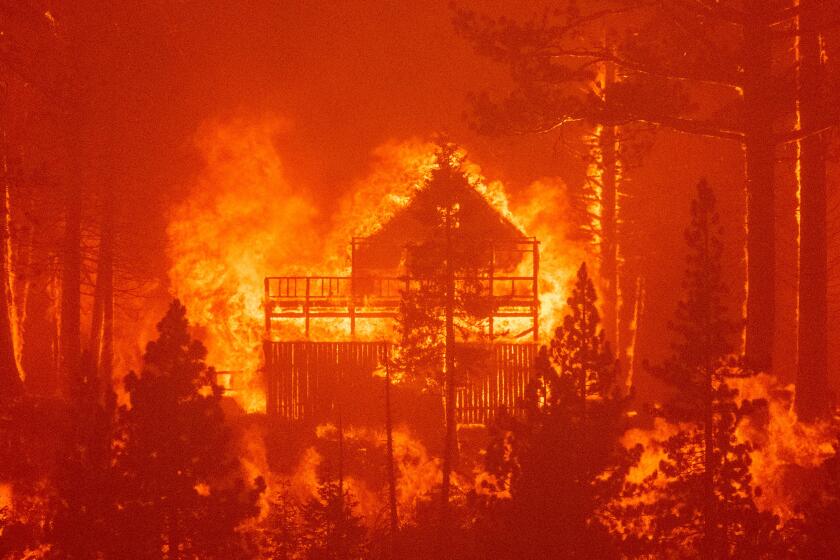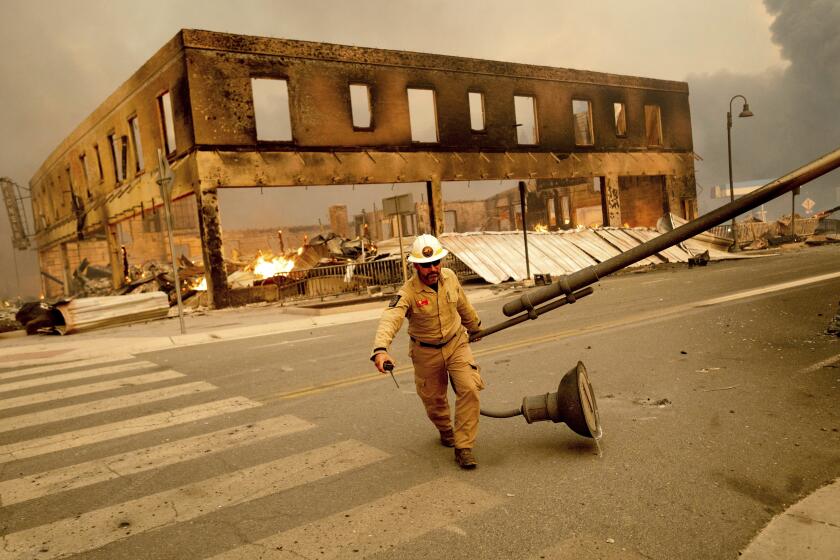The Dixie fire threatened to pass 1 million acres, then was stopped in its tracks. Here’s how
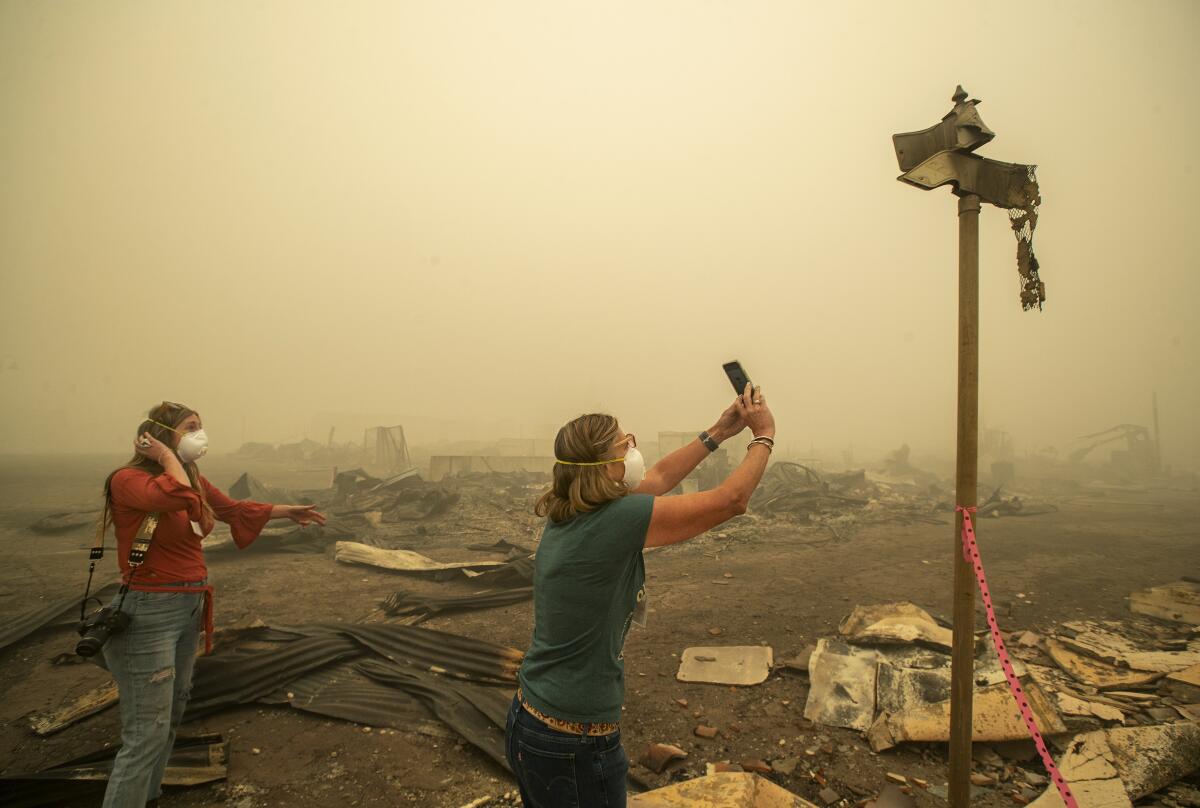
When the Dixie fire sparked in Plumas County on a warm afternoon in July, few could have known that it would morph into the monster it soon became. A downed tree, a blown power line fuse and a small ring of fire were all it took to create the second-largest wildfire in California history.
In the days and weeks after the fire began, it produced one ominous sign after another — generating its own lightning, burning clear across the Sierra and, most horrifically, reducing the town of Greenville to ashes.
Soon it was threatening to surpass the size of the August Complex of 2020, the largest wildfire in California history, which burned more than 1 million acres.
But after nearly two months of nonstop expansion, something shifted. Seemingly overnight, the weather grew more favorable, the fiery terrain leveled out, and crews were able to turn a corner on the massive blaze. The Dixie fire stopped growing, as if frozen in time, at about 963,000 acres. As of Friday, it was 94% contained.
It was a hard-won victory, and experts say there is much to be learned from the Dixie fire — an unprecedented fire even in an era of unprecedented fires.
“We just can’t get used to these kinds of numbers,” said Scott Stephens, a professor of fire science at UC Berkeley. “That size is just mind-blowing.”
PG&E reported the information to the California Public Utilities Commission, noting that blown fuses and a tree may have contributed to the Dixie fire.
Many experts said the speed and scale of the Dixie fire’s spread sent a clear message about the toll extreme heat and drought are having on California’s overgrown landscape. It also amplified the urgent need for more proactive measures to prevent similarly massive fires.
“The Dixie fire is the final, nail-in-the-coffin piece of evidence that traditional firefighting methods are not up to the challenge of the kind of wildfires we get in the 2020s,” said Chris Field, director of Stanford University’s Woods Institute for the Environment. “Basically, this fire jumped over everything that we would have considered a traditional defensible fire line.”
Field attributed a few factors to the Dixie fire’s growth — most critically, the century of fire suppression that enabled vegetation to pile up in the state’s forests. When that drought-dried vegetation met with embers from the Dixie fire, it easily ignited, enabling the blaze to “carve its own path like a glacier.”
“It’s a really scary confirmation of the extensiveness of the fuel buildup,” Field said, “and that basically we’re in an era now where any place you drop a match or a burning ember, you get a new fire. And that vulnerability is really hard to deal with.”
The Dixie fire also confirmed that the August Complex was not the anomaly many hoped it would be. In fact, six of the 10 largest fires in the state’s history have burned in the last two years, according to the California Department of Forestry and Fire Protection.
And in many ways, the Dixie fire was more fearsome than the August Complex. That blaze was composed of more than 30 smaller fires that ignited after an unusually fierce lightning storm in Northern California.
This fire, on the other hand, merged only with one smaller blaze to form a singular inferno.
“This Dixie fire is one fire, so it’s not a complex of multiple fires,” said Tim Phelps, an incident spokesman for the Dixie fire. “It’s uncharted territory.”
Phelps said the critical dryness of the landscape helped fan the fire’s expansive growth throughout July and August.
“What is unique this year, compared to previous years, is just how dry that material is,” he said of the trees and grasses the fire seared. “Because of this drought, because of the lack of moisture for such an extended period of time, [those fuels] are incredibly receptive to fire. Fire spreads easier, it spreads faster.”
For months, fire officials warned residents that conditions were ripe for disaster.
Vegetation was at record dryness heading into fire season, and it grew drier over the rainless summer. Worsening drought conditions shrank the state’s reservoirs to historic lows, with officials across the West declaring water emergencies.
“Early on, wind and terrain was a huge factor,” said Joe Zwierzchowski, an incident spokesman for the Dixie fire’s east zone, noting that rugged, steep landscape made it difficult for crews to get in front of the fire. “Then you tack on high winds and extremely dry conditions, and you have a powder keg of worst-case scenarios all lined up in one.”
Those conditions lasted for several weeks, when containment gains were hard to come by and even harder to hold. But when the weather backed off, the wind died down, and the flames moved into more favorable territory. “It got to a place where we could fight the fire,” he said.
The conditions that paved the way for the Dixie fire’s growth are becoming more common.
Officials on the fire’s west zone also noted that a spot of rain and slower winds allowed them to get ahead of the flames. When the fire reached Hall’s Flat and other less-steep areas in Lassen County, crews were finally able to forge ahead with bulldozers and hoses — playing offense after months of defensive moves.
“Everything basically was the right spot at the right time, for the first time, on the fire,” west zone spokesman Chris Ziegler said.
Ziegler also credited a history of prescribed burns — including a project in Warner Valley this spring — for slowing the spread and protecting a community in the fire’s path. Prescribed burns help clear dried vegetation, essentially a fire’s fuel, before a wildfire arrives.
The burn scars of other nearby fires, including the Walker, Hog, Sheep and Beckwourth Complex fires, also lent a hand, he said, because their lack of fuel gave the flames nowhere to go.
But while smart firefighting made a significant difference, timing and luck were also essential in stopping the Dixie fire. The blaze’s behavior was erratic and unpredictable throughout most of its run.
“The essential feature of these mega-fires is that we don’t have any way to put them out when they’re in their prime habitat,” Field said.
The Caldor fire has also changed the view of fire risk in Lake Tahoe.
Stephens, of UC Berkeley, said the overgrown conditions of the forest were by far the biggest piece of the puzzle. In certain areas, the landscape was so dry that the likelihood of an airborne ember igniting a spot fire was higher than 90% — a near guarantee.
“The fires this year were very efficient at basically propagating themselves by spotting, just by embers,” he said.
Like others studying the state’s fires, Stephens said that decades of inaction — coupled with climate change and the current two-year drought — were a perfect recipe for the Dixie fire because they kept fuel moistures critically low and highly receptive to fire.
“It shows the vulnerability of our forests and landscape,” Stephens said of the Dixie fire. “Climate change and the drought adds to the vulnerability, but the biggest piece I’d still say is the condition of our forest. I’d say it’s 75% of our problem.”
Many ecologists have noted that fire is not only necessary but healthy for California’s landscape. Already this year, prescribed burns have been credited with helping save the state’s beloved giant sequoias from the KNP Complex burning inside Sequoia National Park.
The Dixie fire, too, may be restorative for the state’s landscape, Stephens said. Portions of the fire burned under moderate conditions that will likely lead to a healthier forest in the long run, although there were some patches that may have suffered catastrophic damage.
“But the problem is, the price is too high,” he said. “The price is Greenville burning up, maybe 700 houses lost, and whole economies being disrupted for months.”
The destruction by the Dixie fire of a large swath of the Gold Rush town of Greenville left residents stunned and mourning all that has been lost.
Fewer wildfires and more controlled burns — as well as the reintroduction of Indigenous burning practices that were aggressively stamped out by fire-suppression policies — may be the best path forward for the state, and will help create a mosaic of burned areas that could keep wildfires like the Dixie from spreading out of control, he added.
But transitioning into more of a “stewardship mode,” where fuel treatments are performed and maintained at scale, will require renewed effort and resources. Gov. Gavin Newsom on Thursday signed a $15-billion climate package, the largest such investment in state history, which will include about $1.5 billion toward wildfire response and forest resilience.
And President Biden’s expansive infrastructure bill, if passed, would allow for more than $3 billion for wildfire-risk reduction, including mechanical thinning, controlled burns, infrastructure projects and structural defense, all of which will most certainly be needed in the years to come.
The alternative to doing that work, multiple experts said, is a future of far more Dixie fires.
More to Read
Sign up for Essential California
The most important California stories and recommendations in your inbox every morning.
You may occasionally receive promotional content from the Los Angeles Times.
